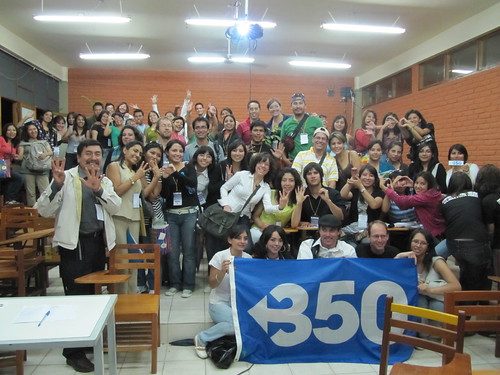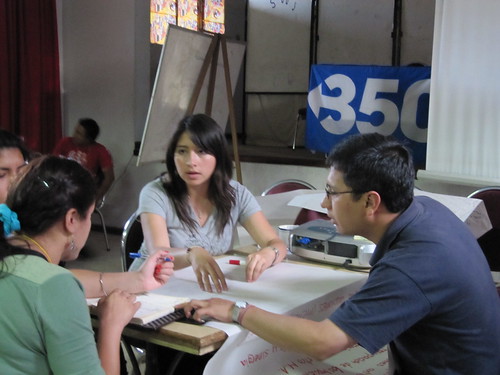
Photo by Paula Collet
Last Thursday, I found myself on the 5th floor of the social sciences building of the Universidad del Valle, the site of the World People's Conference on Climate Change and the Rights of Mother Earth, sitting in a room of about 40 civil society and government representatives from around the world. Together, we were putting the finishing touches on the final document for the summit, that would be read minutes later to a packed stadium of over 20,000.
As the presidents of the 17 working groups haggled over small changes in wording that were projected up on the screen, I couldn't help but think how utterly different this experience was than the final hour in Copenhagen; civil society shut out of the building, just a few countries trying to decide our fate, and without so many of the countries whose future would be sold out by the Copenhagen Accord. So 4 Days, 20,000 people, countless cultures and perspectives later — what has been accomplished in Cochabamba, and where do we go from here?
To start, here's a great video summary from our friends Tupac Saavedraand & Lauren Rosenfeld reporting for Yes! Magazine to get a flavor of what the conference was like, and a few takes on its symbolism moving forward:
A counterbalance
The idea of the Cochabamba People's Accord coming out of the summit is for this document to serve as a counterweight, or people's alternative, to the weak and inadequate Copenhagen Accord, which the U.S. principally is trying to jam through the UN process. The submission period for the UN's Climate Change Framework is open until April 26th, leaving the Bolivian government just enough time to present the final document forged with government and civil society representatives before the official process. Aside from the radical positions contained in the document, the process through which it was created is a statement in itself. In Copenhagen, we saw the idea of democracy to solve this problem threatened – the analysis was that 192 countries was simply too many to try to come to a concensus – better to lock out those whose survival was at stake to be able to at least agree to something between the biggest polluters. Bolivia turned this on its head, opening up the process further to another major voice who wasn't able to be in the room, civil society.
Speaking in front of 20,000 people, and representatives of the Mexican government at the closing ceremony, 350's own Marcelo Quintanilla had the chance to issue the challenge to the Mexican government to make Cancun just as representative and open as the Bolivia summit has been (video coming soon!).

Movement building
As Naomi Klein says in this great article, "When Morales invited social movements and Mother Earth's defenders…scientists, academics, lawyers and governments to come to Cochabamba for a newkind of climate summit, it was a revolt against this experience of helplessness [in Copenhagen], an attempt to build a base of power behind the right to survive." Bolivia, like the island and African countries, are the countries most vulnerable to climate change, and who have the least power to confront it. They see a way forward in collaborating with the biggest social movements in the world to really put pressure on the governments who, while Bolivia's glaciers melt and islands begin to go under, insist that real change is still "politically unrealistic".
In Cochabamba, social movements found their climate champions, and vulnerable governments found their backing. The bridges built between the vulnerable nations present in Cochabamba and massive global and regional social movements like Via Campesina, indigenous movements, and 350 could really provide some major pressure at the international level if we are able to work together effectively. How this coordination will work out remains to be seen, yet I have high hopes given the commitment and trust that the Bolivian government has helped to build. And we certainly need this kind of strength and unity in order for our movement to succeed – stay tuned here for what people are planning from the Action Strategies working group that I was apart of.
After an exhausting week, on Friday and Saturday, we settled in to two more days of talking and organizing. Together with some of our main partners in Bolivia, we helped pull together a small summit of about 50 leaders of youth networks from around Bolivia and around all ofLatin America. Despite being from so many different countries and perspectives, the conversations on these two days were some of the most positive, constructive, and action-oriented I saw all week. In just two days, they mapped out their vision for the future, their vision for a real connected movement of Latin American youth, and came to concensus on some real concrete next steps in organizing for 10/10 and Cancun.
With over half the world's population under 30 these days, we feel it crucial to be supporting and strengthening youth climate movements around the world.

Lessons from indigenous and traditional ways of life
One of the most important messages (despite the overblown press on chicken and baldness) coming out of the Bolivian summit are the lessons of the country's indigenous people – principally the idea of"vivir bien" or "living well". This is the kind of thinking – living well rather than living large – that societies like mine (the United States) and many other consumptive societies need desperately to understand. And you see it, and feel it, everywhere in Bolivia. Things work differently, and people may have far less stuff than they do in the U.S. or elsewhere (which has never been proven to make us any happier), but things work in their own way. They may not have many supermarkets, but you can find fresh fruits and vegetables from a woman's stand on the corner any time. They may not have many of the comforts we think necessary to modern life, but they do have a participatory democracy, a clear way to make their needs and demands heard.
Vivir bien is a concept I hope that our work for 10/10/10 will help to spread – that through thousands of community-based projects that begin to implement climate solutions locally, we can see a future that is more local and community-oriented, less consumptive, and that shows us the power we have together to make the transition to a just ,sustainable, fossil fuel-free society.
For more coverage of the summit, please check out the following links from some of our friends and allies:
Yes! Magazine: https://www.yesmagazine.org/blogs/a-peoples-climate-summit
Democracy Now: https://www.democracynow.org/tags/world_peoples_summit_on_climate_change
The Democracy Center: https://democracyctr.org/index.php
Climate Voices: https://climatevoices.wordpress.com
Movement Generation: https://www.movementgeneration.org/